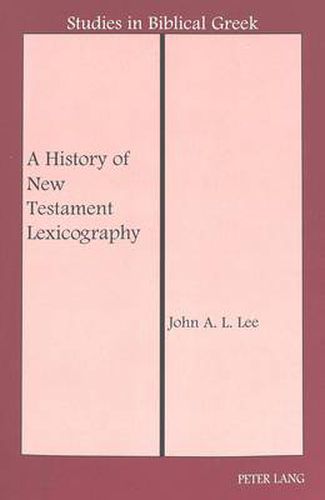Readings Newsletter
Become a Readings Member to make your shopping experience even easier.
Sign in or sign up for free!
You’re not far away from qualifying for FREE standard shipping within Australia
You’ve qualified for FREE standard shipping within Australia
The cart is loading…






This title is printed to order. This book may have been self-published. If so, we cannot guarantee the quality of the content. In the main most books will have gone through the editing process however some may not. We therefore suggest that you be aware of this before ordering this book. If in doubt check either the author or publisher’s details as we are unable to accept any returns unless they are faulty. Please contact us if you have any questions.
New Testament lexicons of today are comprehensive, up-to-date, and authoritative. Behind them lies a tradition dating back to the sixteenth century, whose characteristics are not well known. Besides giving a history of this tradition, A History of New Testament Lexicography demonstrates its less satisfactory features, notably its dependence on predecessors, the influence of translations, and its methodological shortcomings. John A. L. Lee not only criticizes the existing tradition, but stimulates thought on new goals that New Testament lexicography needs to set for itself in the twenty-first century. This book caters to the non-specialist as well as those interested in philological detail.
$9.00 standard shipping within Australia
FREE standard shipping within Australia for orders over $100.00
Express & International shipping calculated at checkout
This title is printed to order. This book may have been self-published. If so, we cannot guarantee the quality of the content. In the main most books will have gone through the editing process however some may not. We therefore suggest that you be aware of this before ordering this book. If in doubt check either the author or publisher’s details as we are unable to accept any returns unless they are faulty. Please contact us if you have any questions.
New Testament lexicons of today are comprehensive, up-to-date, and authoritative. Behind them lies a tradition dating back to the sixteenth century, whose characteristics are not well known. Besides giving a history of this tradition, A History of New Testament Lexicography demonstrates its less satisfactory features, notably its dependence on predecessors, the influence of translations, and its methodological shortcomings. John A. L. Lee not only criticizes the existing tradition, but stimulates thought on new goals that New Testament lexicography needs to set for itself in the twenty-first century. This book caters to the non-specialist as well as those interested in philological detail.